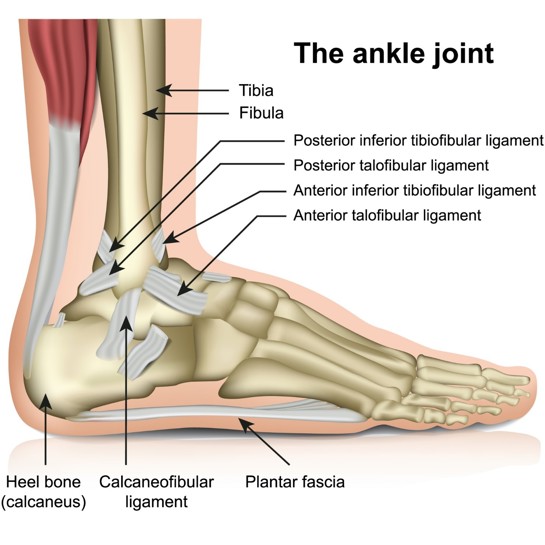
This article is part one of a three-part series where Dr. Jeremy M. Saller answers common questions about ankle sprains, from the injury to diagnosis and treatment. Dr. Saller specializes in the treatment of foot and ankle issues.
Ankle sprains are a common injury that can occur in people of all ages through many everyday activities. An estimated 2 million ankle sprains occur in the United States each year. This type of injury often happens when you walk on an uneven surface, trip over something, or roll your ankle during running or cutting activities while playing sports.
What is a sprained ankle?
Your ankle is the joint that connects your foot to your leg. It’s freely mobile, which allows you to walk, run, jump, dance and more. The ankle joint is held together by ligaments, which are tough bands of tissue that connect one bone to another bone.
An ankle sprain occurs when any of these ligaments is stretched or torn. The most common type of ankle sprain is an inversion injury, which happens when the foot rolls inward underneath the leg and damages the ligaments on the outside of your ankle.
What are the symptoms of ankle sprains?
Common ankle sprain symptoms are pain, swelling, and bruising at the affected area of the ankle. In cases of severe swelling, the foot and toes may be cold and numb due to lack of blood flow. Pain is usually worse when putting any weight on the ankle.
Anatomy of an ankle
Ligaments aren’t the only important pieces. Your ankle is a complex joint that also includes bones, tendons, cartilage and muscles. For this post, I’ll focus on the main bones and ligaments that could be involved in an ankle sprain.
Three bones converge
At the top of the ankle joint, there is the larger tibia bone and the smaller fibula bone. These two leg bones meet at a dome-shaped bone in your foot called the talus.
Both the tibia and the fibula have a malleolus, which you see as the bony bump on each side of your ankle. Malleolus means “small hammer or mallet” in Latin. The lower end of the fibula comes down on the outside of your ankle and is called the lateral malleolus. On the inside portion of your ankle, the lower end of the tibia is called the medial malleolus. These “little mallets” provide bony structural support to the ankle.
Ligaments band them together
Ligaments are tough bands of tissue that connect bones in your joints and provide additional soft tissue support. In your ankle, there are three main groups of ligaments that stabilize the joint and could be injured in an ankle sprain. They are the lateral ligaments (outer ankle), medial ligament (inner ankle), and syndesmosis ligaments.
Lateral ankle ligaments
These three ligaments on the outside of the joint are weaker and more susceptible to injury.
- Anterior talofibular ligament: This is the ligament that is injured most often in an ankle sprain. Injury can happen if the foot is twisted inwards or inverted.
- Calcaneofibular ligament: This is the second most common ligament injured in an ankle sprain. It is usually injured when the foot is inverted and dorsiflexed (the foot is pointing up toward the knee).
- Posterior talofibular ligament: This is the least common ligament injured on the lateral side of the ankle. If the posterior talofibular ligaments are torn, it is usually torn along with the other two lateral ligaments in a more serious injury.
Medial ankle ligament
Your inner ankle has one large, strong fan-shaped ligament called the deltoid ligament. Injuring your deltoid ligament is not common, but it can happen if the ankle rolls outward. This would typically happen during running or jumping activities, especially on uneven surfaces.
Syndesmosis ligaments
The syndesmosis ligaments attach the fibula and tibia bones just above the ankle joint. They are the ligaments that are injured in a high ankle sprain.
- Anterior inferior tibiofibular ligament (AITFL): This ligament runs between the fibula and tibia on the front of the bones (anterior).
- Posterior inferior tibiofibular ligament (PITFL): This ligament runs between the fibula and tibia on the back (posterior).
- Interosseous ligament (IO): This ligament runs down the middle of the fibula and tibia at the lower leg.
Want to learn more about ankle sprains? Check out the other two parts of this series:
Get the jump on ankle sprains: Ankle sprain diagnosis
Get the jump on ankle sprains: Ankle sprain treatment
About Dr. Saller
Jeremy M. Saller, MD, is a board-certified orthopedic surgeon who practices at BayCare Clinic Orthopedics and Sports Medicine in Green Bay, Wisconsin. Dr. Saller specializes in general orthopedic surgery with a special focus on foot and ankle orthopedics and pediatric orthopedics. He joined BayCare Clinic in the summer of 2023.
A note from BayCare Clinic
The content of this article, including text, images, and graphics, is for general informational purposes only. It is not intended to substitute for professional medical advice, including a medical diagnosis and treatment plan.